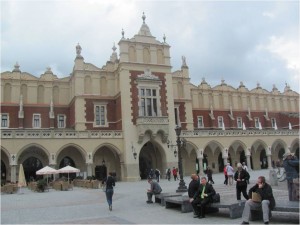Poland’s UNESCO sites
In 1978, first two places from Poland were inscribed on the UNESCO World Cultural and Natural Heritage List: Krakow and Wieliczka. Today, the list includes fourteen unique sites that you cannot miss:
- Historic Center of Warsaw: The historic centre of Warsaw is a unique example of a planned near-total reconstruction of a span of history covering the 13th to the 20th century.
- Castle of the Teutonic Order in Malbork: The castle is considered World’s largest brick building made by human hands.
- Royal Salt Mines in Wieliczka and Bochnia: The deposits of rock salt in Wieliczka and Bochnia have been mined since the 13th century. The mines are the oldest of their type in the world.
- Centennial Hall in Wrocław: One of the 10 most important examples of 20th-century modernism according to the American Getty Foundation. The Centennial Hall is one of the major monuments of Wrocław.
- Park Muzakowski: Park Muzakowski is an outstanding example of horticultural art in Europe.
- Wooden Orthodox churches of the Carpathian Region in Poland and Ukraine : The wooden Orthodox churches built at the turn of the 16th century are the oldest objects of this type preserved in the territory of Polish and Ukrainian Carpathians. The UNESCO List includes 16 churches, of which eight are located in the territory of Poland, and eight in the territory of Ukraine.
- Historic Center of Kraków: The historic centre of Kraków was the first site from Poland to be inscribed on the UNESCO World Heritage List. The 13th-century merchants’ town has Europe’s largest market place and numerous historical houses, palaces and churches.
- Old City of Zamość: Zamość was founded in the 16th century by Chancellor Jan Zamoysky on the trade route linking western and northern Europe with the Black Sea.
- Wooden Churches of Southern Małopolska: The wooden churches of southern Małopolska – Binarowa, Blizne, Dębno, Haczów, Lipnica Murowana, Sękowa – represent outstanding examples of the different aspects of medieval church-building traditions in Roman Catholic culture.
- Churches of Peace in Jawor and Świdnica: The 17th century Churches of Peace in Silesia are the largest timber-framed religious buildings in Europe.
- Kalwaria Zebrzydowska: It is the Mannerist Architectural and Park Landscape Complex and Pilgrimage Park.
- Białowieża Forest: The Białowieża National Park is the only Polish natural heritage site on the
UNESCO List
- Medieval Town of Toruń: Toruń was founded by the Teutonic Order, in the 13th century. The unique spatial layout of Toruń has remained unchanged for 700 years.
- Auschwitz-Birkenau Camp: German Nazi Concentration Camp in occupied Poland 1940–1945 was the largest extermination camp of the Third Reich.



Leave a Reply
Want to join the discussion?Feel free to contribute!